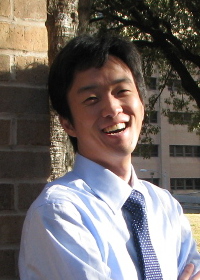Center Members
Braden Brinkman
 |
Ph.D., University of Illinois at Urbana-Champaign Assistant Professor Life Sciences Building, Room 548 |
Dr. Brinkman did his Ph.D. in statistical physics with Karin Dahmen at the University of Illinois at Urbana-Champaign and transitioned into theoretical neuroscience when he joined the labs of Eric Shea-Brown and Fred Rieke at the University of Washington. His current research leverages his statistical physics background to study how the collective dynamics of neurons enable the brain to represent, transmit, and combine information across a larger range of spatial and temporal scales than any individual neuron can access. He is especially interested in elucidating how network structure and dynamics determine a circuit’s computational capabilities, and how pathologies in structure or dynamics may manifest as diseases like epilepsy—and how we might be able to use our theoretical frameworks to design principled interventions to treat diseased networks.
Alfredo Fontanini
 |
M.D., Ph.D., University of Brescia Professor and Chair Life Sciences Building, Room 545 |
Alfredo Fontanini attended the University of Brescia Medical School, Italy and received a PhD in Neuroscience in 2003. After postdoctoral fellowships at Brandeis University from 2002-2008 under the supervision of Drs. Sacha Nelson and Don Katz, he joined the faculty of Stony Brook University, where he is currently Associate Professor of Neurobiology & Behavior. From 2003-2005 he was a Sloan-Swartz Fellow for Theoretical Neurobiology at Brandeis. He serves as a Reviewer and Review Editor for the Journal of Neurophysiology, Neuroscience and Frontiers in Cellular Neuroscience and is a member of the Society for Neuroscience and the Association for Chemoreception Sciences.
Giancarlo LaCamera
 |
Ph.D., University of Bern CNCD Director and Associate Professor |
Giancarlo La Camera studied Theoretical Physics at the University of Rome "La Sapienza" and received a Laurea (M. Sci.) in 1999. He went on to obtain a PhD in Neurobiology from the University of Bern in 2003. Between 2004 and 2008 he was a visiting fellow at the National Institute of Mental Health, where he performed research on the neural basis of cognitive functions. He then returned to the University of Bern where he focused on the topic of reinforcement learning in populations of spiking neurons. In early 2011 he joined the faculty of Stony Brook University as an Assistant Professor of Neurobiology & Behavior and was promoted to the rank of Associate Professor with tenure in 2017.
Arianna Maffei
 |
Ph.D., University of Pavia Professor Life Sciences Building, Room 546 |
Arianna Maffei graduated in Biology from the University of Pavia (Italy) in 1997 and received a Ph.D. in Physiology from the University of Pavia in 2001. She was a postdoctoral scholar at Brandeis University from 2002 to 2008. In 2008, she joined the faculty of the Department of Neurobiology & Behavior at Stony Brook and became Associate Professor in 2014. Dr. Maffei is an associate editor for Frontiers in Cellular Neuroscience and The Journal of Neuroscience, and is a member of the editorial board of iScience. She is a member of the Society for Neuroscience and the Association for Chemoreception Sciences (AChemS).
Memming Park
 |
Ph.D., University of Florida Group Leader, Champalimaud Centre for the Unknown, Lisbon Email: memming.park@stonybrook.edu |
I. Memming Park (박일) received a B.S. in computer science from KAIST in 2005. He received an M.S. in electrical and computer engineering in 2007 and a Ph.D. in biomedical engineering in 2010 from the University of Florida working with José C. Principe. He was a postdoctoral fellow (2010-2014) at the University of Texas at Austin working with Jonathan Pillow, before he joined the faculty of neurobiology and behavior at Stony Brook University in 2015.
Jin Wang
 |
Ph.D., University of Illinois at Urbana-Champaign Professor Chemistry Building, Room 433 |
Jin Wang got his Ph.D. in astrophysics with Prof. Dmitri Nanopoulos at University of Illinois at Urbana-Champaign in 1991. After postdoc experiences in chemistry and biophysics with Prof. Peter Wolynes at University of Illinois (1991-1996) and as visiting scientist at the National Institutes of Health (1996-1997), he went to the financial industry to perform credit risk modeling (1997-2004). He joined the faculty of Stony Brook University in 2004 where he is currently a professor of Chemistry and of Physics and Astronomy. His main research interests include the physics and chemistry of molecular and systems biology, equilibrium and nonequilibrium statistical mechanics, and the link between neural circuit dynamics and brain function. He is a fellow of the American Physical Society (2010) and a fellow of American Association for the Advancement of Science (2012).
Siwei Wang
 |
Ph.D., University of Chicago Assistant Professor Life Sciences Building, Room 550A |
Dr. Wang earned her doctorate from the University of Chicago in machine learning and speech processing before transitioning to theoretical neuroscience as a postdoctoral fellow at the HU-Max Center for Sensory to Action, where she collaborated with Naftali Tishby, Idan Segev, and Alexander Borst. Additionally, she worked with Professor Stephanie Palmer prior to joining Stony Brook University. Her previous work has shown how information processing during survival-critical behaviors sculpts early neural systems. She uses information theory, Bayesian inference, and representation learning methods to investigate how neural representation evolves along the sensory-to-behavior arc to enable effective future action planning based on past experiences.
![]()
